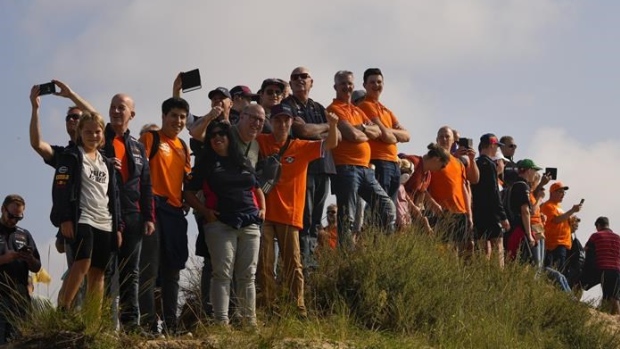Sep 3, 2021
Verstappen fans turn a seaside town orange for Dutch GP
As the doors to trains slid open in the seaside town of Zandvoort, hundreds of racing fans in orange T-shirts poured out. Dutch driver Max Verstappen's “Orange Army” of fans had arrived.
The Canadian Press

ZANDVOORT, Netherlands (AP) — As the doors to trains slid open in the seaside town of Zandvoort, hundreds of racing fans in orange T-shirts poured out.
Dutch driver Max Verstappen's “Orange Army” of fans had arrived.
They are hard to miss at the best of times — they pack stands at Austria's Grand Prix — home of his Red Bull team — and at Belgium's Spa-Francorchamps track, very close to where Verstappen was born and raised.
This weekend, with Formula One racing returning to Zandvoort for the first time since Niki Lauda won the last Dutch Grand Prix in 1985, they are ubiquitous.
At a railway station in the Dutch city of Leiden, two men wearing bright orange work overalls and a young girl in a regal cape made of bright orange fake fur waited for their train to Zandvoort.
Dutch sports fans are always easy to spot at events like the Olympics and soccer World Cups, sporting clothes ranging from three-piece suits to wooden shoes to feather boas in orange — the color of their country’s royal family.
The 23-year-old Verstappen has yet to wear the F1 crown, but he must feel like royalty, for wherever he goes the “Orange Army” follows in huge droves.
With good reason, perhaps, for the stunningly quick and fearless Verstappen is one of the brightest talents to emerge in F1 for many years.
The youngest driver to race in F1, aged 17; the youngest to win, at 18, on a stunning debut for Red Bull that earmarked him as a future world champion.
“The level of support he’s got is fantastic,” Red Bull team principal Christian Horner said.
But Lewis Hamilton is still around, and Verstappen is pushing hard to stop the Mercedes star from winning a record eighth F1 title to move one ahead of Michael Schumacher, who was once a teammate of Verstappen's father, Jos.
Verstappen's devoted followers are hoping their support will help propel him to victory on Sunday and back to the top of the F1 drivers standings.
“It won't be easy, but if he gets pole he should win,” said Roger Seetsen, who traveled from the southern province of Limburg and was camping in the dunes next to Zandvoort's undulating 4.3-kilometer (2.7-mile) circuit for the entire long weekend.
“You only have a couple of places where you can overtake here, but with the support of all his fans, Max should succeed,” Seetsen said as he enjoyed a morning snack at a beachside seafood stand.
After 35 years without a home Grand Prix, the global coronavirus pandemic forced Dutch F1 fans to wait another year. And this year crowds are limited to 67% of the track’s capacity — about 65,000 fans per day — with fans having to show a corona pass to get into the venue.
Even with those restrictions, the town's mayor, David Moolenburgh, was delighted with the global television spotlight on this town of 17,000 and the likely economic spinoffs for local businesses.
“But for me, the most important is the happiness of the townsfolk — the way they have embraced the race,” he said.
Moolenburgh was right.
On one long road that leads from the train station to the track, locals hung checkered flags from their windows.
On Thursday, the day before the first practice, residents flooded the streets around the track. Some had tickets to walk around it while others waited patiently at the outside gates until the early evening, hoping for a glimpse of Verstappen and other drivers.
Not everybody was happy — environmentalists launched a series of legal challenges to the event, with a judge dismissing a request to halt the race just days before the event.
The logistics of getting visitors in and out of Zandvoort were also a headache. Thousands of race fans left their cars at home and jumped on that most Dutch mode of transport — the bicycle. Tens of thousands of temporary bike parking places sprung up around the town.
Zandvoort is known for fans being able to watch racing from the rolling sand dunes alongside the track. But that has been ruled out this year because of COVID-19 restrictions — although plenty of supporters still managed to find a vantage point in the grassy dunes.
Local resident Elisabeth de Jong had her dune ticket canceled, but she wasn’t going to let that spoil her weekend.
She and her neighbors put up a white tent outside their house near the race track, festooned it with orange and checkered flags and a big Dutch flag emblazoned with "MAX VERSTAPPEN” and the young Dutchman’s race number, 33.
“It’s so cool that he can race in his home country,” De Jong said as orange-clad fans streamed past her front door.
___
More AP auto racing: https://apnews.com/hub/auto-racing and https://twitter.com/AP_Sports
